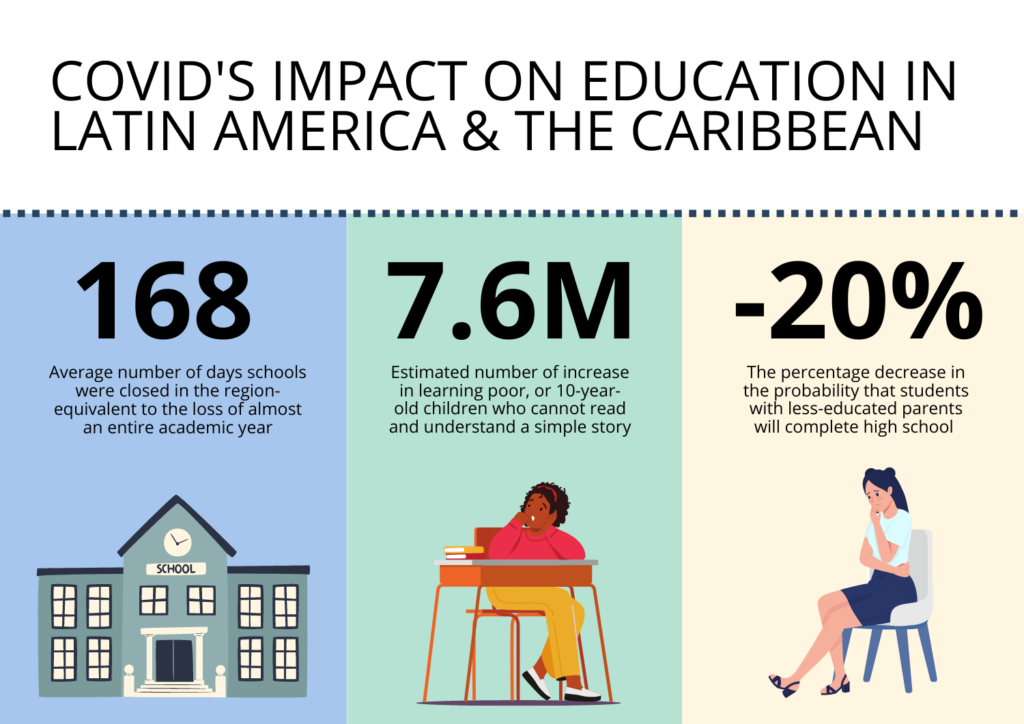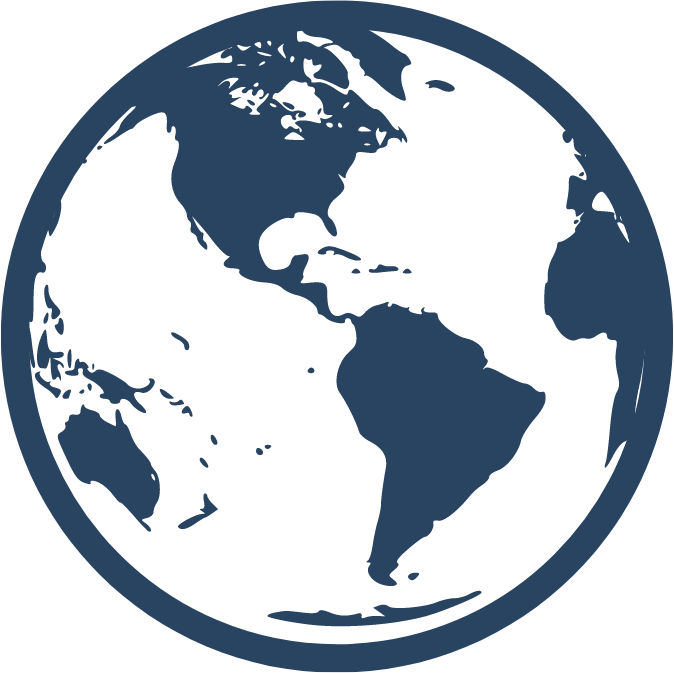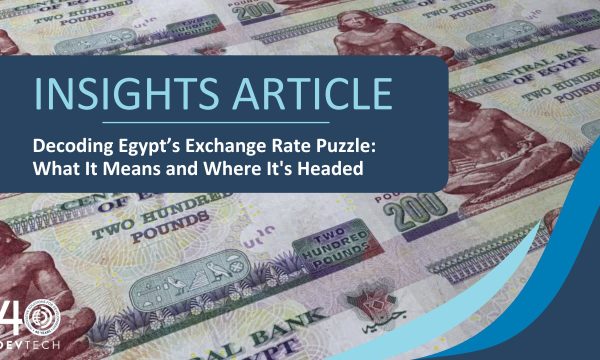The COVID-19 pandemic has been the greatest shock to education systems in the Latin America and Caribbean (LAC) region in recent history. It caused widespread school closures throughout the region, with a total of 23 countries and 12 independent states closing their educational establishments for an average of 168 days from the start of the pandemic in March 2020 until the beginning of February 2022—equivalent to the loss of almost an entire academic year. As a result, it is estimated that more than 159 million children stopped attending school, representing more than 95 percent of enrolled learners in LAC. For most countries, over 90 percent of children were able to participate in distance learning activities not long after the school closures. However, countries like Bolivia (22.6 percent), Honduras (17 percent), and Guatemala (13.3 percent) had a high percentage of children who were not engaged in educational activities (World Bank, 2021).[1]

As a result of learning losses during the pandemic, it is projected that learning poverty – the percentage of 10-year-old children who cannot read and understand a simple story – could increase from 51 to 62 percent of students in the region. This would represent roughly an increase of 7.6 million learning poor.[2] The World Bank estimates that the percentage of lower-secondary students below the minimum proficiency level—that is, students that don’t meet the benchmark of basic knowledge in a specific domain as measured through PISA standardized test scores—could increase by 16 percentage points, from 55 percent at baseline to 71 percent at endline.[3]
The pandemic will undoubtedly exacerbate existing educational inequalities in the region. At the country level, it is estimated that relative learning loss will be higher in countries that were already worse-off before the pandemic. The EduTrends research team conducted a simulation of the effect that school closures will have on learning-adjusted years of schooling (LAYS) across the region and on the percentage of students below the minimum proficiency.[4][5] Through this simulation, they found that if schools stay closed for 10 months—a reality for several countries of the region, including Venezuela, Honduras, Panama, and Mexico, where schools remained closed for 12 months or more—and considering a medium level of mitigation effectiveness, on average, the loss of LAYS could be as high as 1.3 years, from a baseline of 7.7 years. In this scenario, the loss in absolute terms could be higher for countries that had a better LAYS at baseline, before the COVID-19 pandemic. For example, in Chile and Trinidad and Tobago LAYS could drop by 1.5 years, while in Honduras and Guatemala LAYS could be reduced by 1.1 and 1.2 years, respectively. However, in relative terms, with very few exceptions the loss in learning would be proportionally greater in countries with lower LAYS prior to school closures. The Dominican Republic, Guatemala, and Honduras could lose 18 percent of pre-COVID-19 LAYS, and Panama could lose up to 20 percent.
The COVID-19 pandemic is also likely to have the long-term effect of amplifying inequality. On a socioeconomic level, many students, particularly those from lower socioeconomic backgrounds who were already learning little before the crisis, will disengage and/or drop out of school. In the long term, the likelihood of poor children completing secondary school will be substantially reduced, limiting upward intergenerational mobility (Lustig, Neidhöfer, and Tommasi, 2021). Absolute upward mobility refers to the likelihood or probability that children with low-educated parents will complete high school. Top persistence is the likelihood or probability that children with highly educated parents will complete high school. As shown in Figure 3, the likelihood of children with highly educated parents completing high school (or secondary education) is unlikely to change much. On average, it will be reduced by 4.6 percent, meaning that 95 out of 100 students in this category will complete high school. However, the probability that students with less-educated parents will complete high school will be reduced by around 20 percent.Brazil, Venezuela, Peru, and Mexico will experience the highest reduction in absolute upward mobility, by 32, 30, 28, and 27 percentage points, respectively. In El Salvador, Guatemala, and Honduras, which already had the lowest rates of upward mobility before the pandemic, students will see their chances for improved socioeconomic status further decline due to the pandemic.
Figure 3: Intergenerational Transmission of Lockdown Consequences

Sources: USAID LAC Support Contract (2022); Lustig, Neidhöfer, and Tommasi (2021)
While the negative impact of the COVID-19 pandemic on learning outcomes in LAC is unfortunately inevitable, the region’s strength in education sector monitoring provides some hope. Indeed, reliable information on learning outcomes, including socio-emotional skills, is available for a wide range of countries given the region’s consistent and wide implementation of international and national tests—a trend unique to LAC among developing countries (Bruns et al. 2019).[6] As expressed by The World Bank et. al (2021): “It is critical for policymakers, school administrators, and teachers to have access to learning data that reflect their context, and for learning data to be disaggregated by various sub-groups of students, so that they can target instruction and accelerate students’ learning recovery.” By relying on assessment data using many of the tools they already have experience implementing, countries from the LAC region may yet avoid Lustic et al.’s (2020) prediction that the current generation of LAC school children—especially in low income, less educated households—may be facing a future with the meager levels of education achievement last seen in the 1960s.
To learn more about recent education trends in the Latin America and Caribbean region, as well as the COVID-19’s impact on the region’s education system, read the “A Summary Analysis of Education Trends in Latin America and The Caribbean – 2022 Update” report, developed by DevTech’s USAID Latin America and Caribbean Support Contract team.
Endnotes
[1] This indicator refers to overall “engagement in any education or learning activity,” and does not specify the type, quality, or frequency of the engagement. The data comes from high-frequency phone surveys, which might limit the weight of informants from rural areas.
[2] See: Learning Poverty (worldbank.org).
[3] Programme for International Student Assessment (PISA)
[4] Simulation undertaking using data from the World Bank’s COVID-19 learning loss simulation tool.
[5] LAYS combines the amount of schooling that children typically reach with the quality of learning during school years.
[6] Venezuela and Bolivia are exceptions to this trend, lacking a robust national assessment system since 1998 and 2000, respectively.
References
Bruns, B.; Akmal, M.; and Birdsall, N. (2019). The political economy of testing in Latin America and Sub-Saharan Africa (No. 515). Center for Global Development. Available at: https://www.cgdev.org/sites/default/files/political-economy-testing-latin-america-and-sub-saharan-africa.pdf
Kuhfeld, Megan, James Soland, and Karyn Lewis. (2022). Test Score Patterns Across Three COVID-19-impacted School Years. (EdWorkingPaper: 22-521). Retrieved from Annenberg Institute at Brown University: https://doi.org/10.26300/ga82-6v47
Lustic, N.; Neidhöfer, G.; and Tommasi, M. (2020, December 3). Back to the 1960s? Education may be Latin America’s most lasting scar from COVID-19. Retrieved from https://www.americasquarterly.org/article/back-to-the-1960s-education-may-be-latin-americas-most-lasting-scar-from-covid-19/
UNESCO. (2021). Habilidades socioemocionales: Empatía, apertura a la diversidad y autorregulación escolar en estudiantes de sexto grado de la región, ERCE 2019. Available at: https://unesdoc.unesco.org/ark:/48223/pf0000380416
The World Bank, UNESCO and UNICEF (2021). The State of the Global Education Crisis: A Path to Recovery. Washington D.C., Paris, New York: The World Bank, UNESCO, and UNICEF.
The World Bank. (2020, July). COVID-19 in LAC. High frequency phone surveys. Results second wave. Retrieved from: https://microdata.worldbank.org/index.php/catalog/4069/download/51147
World Bank. (2021). Acting now to protect the human capital of our children. The costs of and response to COVID-19 pandemic’s impact on the education sector in Latin America and the Caribbean. Retrieved from: https://openknowledge.worldbank.org/handle/10986/35276
World Bank. EdStats online database. Available at: https://databank.worldbank.org








